The bottom line on the Buffalo Bills' 2010 season was that it was more of the same.
Now, it is 11 consecutive years that the Bills have missed the playoffs.
However, there were parts of what they did during an otherwise forgettable 4-12 campaign that indicated they might very well be taking meaningful steps toward an escape from the familiar frustration of the past decade.
One is that the Bills' offense showed signs of being more explosive, even if it did finish in the NFL's bottom eight in total yards for the eighth season in a row. In his first year as Buffalo's coach, Chan Gailey demonstrated that he has the know-how to get more from the Bills' offensive talent than his recent predecessors. Ryan Fitzpatrick showed that he can, at the very least, be a solid quarterback and occasionally much more than that. The emergence of multiple playmakers transformed the receiving corps from an area of weakness to one of impressive depth.
In addition, the Bills' most encouraging move of the offseason so far is adding considerable coaching experience with the hiring of Dave Wannstedt as assistant head coach and inside linebackers coach. His presence figures to provide the Bills help where they need it most: On defense.
Here's a look at some of the team's key offseason issues:
1. What to do with the third pick?
Draft failures are the primary reason that the Bills have become strangers to the playoffs.
They have missed at multiple positions, but none bigger than quarterback. Trent Edwards, a third-round pick in 2007, was dumped after three games last season. Fitzpatrick mostly did well through the balance of the season, but is he good enough to be the long-term answer?
Fitzpatrick seems to have what it takes to help make the Bills more competitive, provided he has the support of a strong running game and a vastly improved defense (which is a huge question mark).
With the third overall pick, however, the Bills could very well be in line to land a quarterback whose skills could eventually elevate them into being a serious contender. That presumes, of course, that Auburn's Cam Newton -- the one quarterback widely viewed as being worthy of such a high choice -- can deliver on such lofty expectations. That also presumes that another team -- such as the Carolina Panthers, who have the top overall pick and are unsettled at quarterback -- doesn't select Newton earlier.
If the Bills do take Newton or another quarterback in the first or second round, they could still plan on starting Fitzpatrick for at least another season while a rookie at the position watches and learns. But an argument can be made that they invest the third overall pick in one of the draft's top defensive players, such as Texas A&M outside linebacker Von Miller or Auburn defensive tackle Nick Fairley.
2. What will Wannstedt's impact be?
George Edwards is still the Bills' defensive coordinator, entering his second season in that capacity.
However, it would be naïve to think Wannstedt won't have a major say in what the Bills do defensively. Buffalo's defense needs all of the help it can get after finishing last season 24th in yards allowed, 28th in points allowed, and dead-last against the run. In 11 of the 16 seasons Wannstedt has spent as an NFL head coach (Miami and Chicago) or defensive coordinator (Dallas and Miami), his defenses have ranked in the top 12 of the league.
It will be interesting to see how the Bills' scheme evolves. Last year, the team switched from a 4-3 to a 3-4 base, but wound up retaining some 4-3 elements because of the difficulty many players had with the adjustment. Wannstedt's background is strongly rooted in the 4-3, and it wouldn't be surprising if the Bills continued to at least employ parts of that scheme along with the 3-4, if they don't wind up simply going back to the 4-3.
3. Can Spiller rebound?
It's too early to say he belongs on the lengthy list of Bills draft flops, but rookie running back C.J. Spiller definitely fell well short of the high expectations as a dynamic playmaker that accompanied him as a first-round draft pick.
Of his 98 touches, he had a mere two plays of 20 yards or more. Given Gailey's ability to effectively use running backs on screen passes, Spiller figured to have a large impact on Buffalo's offense as a receiver and a runner. However, Gailey never found a way to consistently get the ball in Spiller's hands in space.
Another area where Spiller must show dramatic improvement is in blocking, although his smallish frame could make that difficult, if not impossible.
Fred Jackson did a superb job as the Bills' primary running back, but the team clearly is going to make Spiller's development a priority.
4. Will Troup, Carrington step up?
After releasing veteran defensive tackle Marcus Stroud in a cost-cutting move, the Bills are clearly going to lean heavily on a pair of 2010 draft picks -- second-round tackle Torell Troup and third-round end Alex Carrington -- who figure to find their way into the starting lineup.
Troup and Carrington have long arms, which help with their ability to fend off blockers. The Bills would like to see Troup become more explosive off the ball, but think that is something he can develop as he gains experience and does a better job of recognizing blocking schemes. They think Carrington needs to work on disengaging from blockers and being more fluid in his movement to the ball.
5. Will the O-line ever be stabilized?
For the second season in a row, the Bills had seven different starting combinations on their offensive line, with 10 players starting at least one game.
Injuries were a problem, taking away from the Bills' ability to get more out of an offense that still managed to show the ability to be explosive largely because of the performances of Fitzpatrick, the receivers, and Jackson.
However, there might have been one significant silver lining resulting from the fact that Eric Wood, who is no slouch as a guard, performing well at center in place of injured center Geoff Hangartner for the final four games of the season. By showing that he might in fact be a better center, Wood could very well find himself permanently entrenched in his new position.
Guard Andy Levitre was the line's best player, and the Bills might be able to get by if they have to use one of the street free agents they picked up last year -- Kraig Urbik or Chad Rinehart -- to fill the other guard spot. Their problems are at tackle. Demetrius Bell was OK on the left side, but right tackle remains a major problem area.
Follow Vic Carucci on Twitter @viccarucci.



